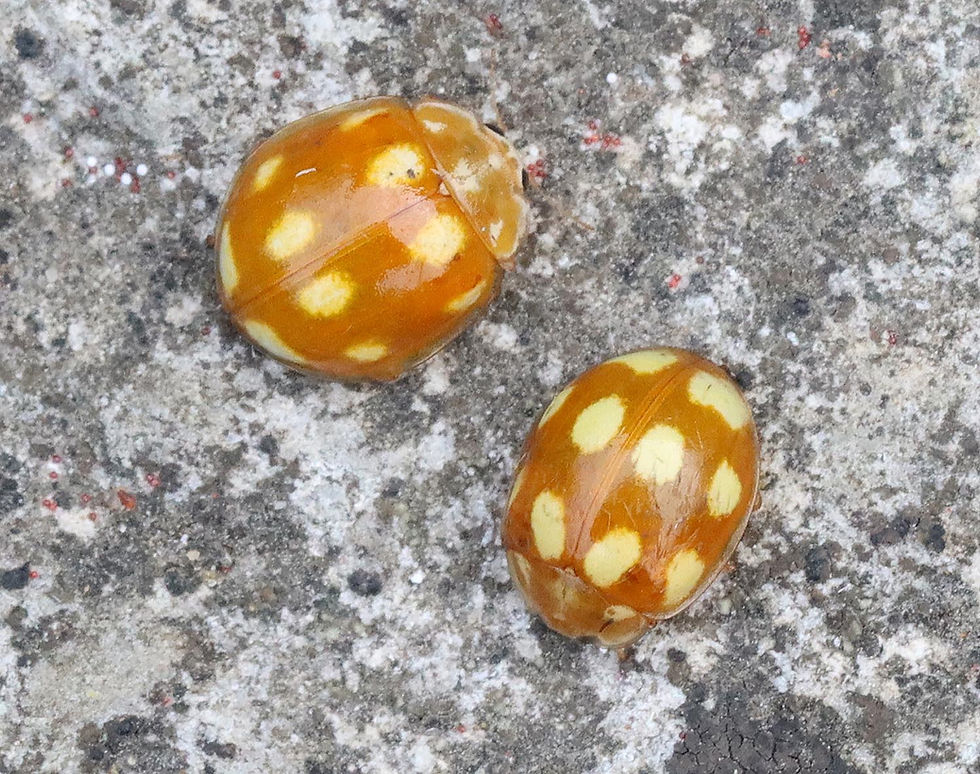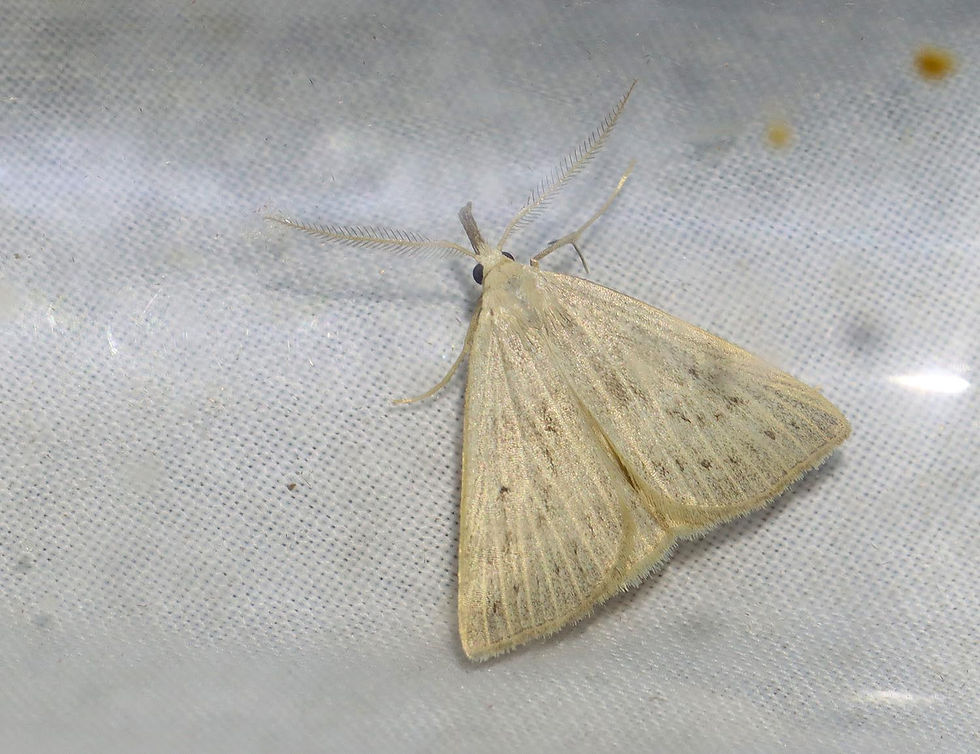New Forest Biodiversity News - June-July 2025
- Russell Wynn

- Aug 21
- 6 min read
This report aims to summarise some of the notable wildlife sightings and conservation news in the New Forest National Park in June-July 2025. To contribute to future editions, please contact the New Forest Biodiversity Forum Chair (russ@wildnewforest.org.uk).
Notable wildlife sightings
Spring 2025 was the warmest and sunniest on record, and the hot and dry conditions continued into early summer, with Met Office data for England indicating it was the warmest June on record (2.5oC above the long term average) and the seventh warmest July. Perhaps surprisingly, Met Office maps show that the New Forest area received about average rainfall during June and July, but even at a local level there seem to be significant variations depending on where any thundery showers hit. Overall, the first half of 2025 has been the driest in England for 50 years, and at the time of writing (mid-August) the open forest is certainly looking extremely dry, with parched grazing lawns and dried-up ponds and streams.
It's been a good year for ladybirds (see here), and a specimen of the ‘Little Arboreal Lady Beetle’ Calvia decemguttata in a garden moth trap in Woodlands on 14 June was the forerunner of a series of records there and at nearby sites in the eastern New Forest, including a larva at Shatterford on 04 July. These follow on from records in Southampton in the last 12 months, and collectively they provide the first evidence for establishment of this species in Britain (which is common in continental Europe and was predicted to make the hop across the English Channel).

Ladybird Calvia decemguttata in a Woodlands garden on 21 June 2025 (photo: Russell Wynn)
The same moth trap in Woodlands also attracted the nationally scarce ground beetle Polistichus connexus on 16 July, which appears to be the first New Forest record. The same garden also hosted a colony of Variable Cockroach for the third year running - this is a relatively new arrival in Britain, and another colony is nearby in Hythe. It also seems to have been a good year for our three native cockroaches (Dusky, Lesser and Tawny), with regular sightings in moth traps and in suitable habitat on the open forest.

Variable Cockroach in a Woodlands garden on 02 Aug 2025 (photo: Russell Wynn)
As part of the New Forest Volunteer Ecological Surveyor Programme (VESPA) a WhatsApp group was established in mid-June for active moth recorders, and in the first six weeks of operation numerous interesting records were generated from trapping on the open forest and in gardens. There were multiple reports of nationally rare/scarce species such as Dingy Mocha, Mocha, Small Chocolate-tip, Olive Crescent, and Light Crimson Underwing, while other nationally rare/scarce species included Mint Cap Pseudopostega crepusculella, Comfrey Ermine Ethmia quadrillella, Sundew Plume Buckleria paludum, Bog Snout Sparganothis pilleriana, White Cloaked Tortrix Gypsonoma aceriana (first New Forest record), Mottled Grey Tortrix Gypsonoma oppressana, Small Brindled Tortrix Gypsonoma minutana, Marsh Grass-moth Crambus uliginosellus, Rolled Grass-moth Pediasia contaminella, Saltern Grass-moth Pediasia aridella, Pied Grey Eudonia delunella, Gorse Knot-horn Pempelia genistella, Saltmarsh Knot-horn Ancylosis oblitella, Rosy Wave, Purple-bordered Gold, Dotted Border Wave, Horse Chestnut, Scarce Merveille du Jour, and Plumed Fan-foot. There was also an influx of some of the scarcer migrant species, notably Small Marbled, while recent colonists such as Blair’s Mocha, Jersey Mocha, Portland Ribbon Wave, Jersey Tiger, Langmaid’s Yellow Underwing, and Tree-lichen Beauty were recorded in good numbers, particularly in the southern New Forest and surrounds. A notable influx of Dark Umber (very rare in the New Forest) and huge numbers of Four-spotted Footman were other highlights of the period.

Dotted Fan-foot near Fritham on 19 June 2025 (photo: Russell Wynn)

Plumed Fan-foot at Lepe on 17 July 2025 (photo: Bob Chapman)
Other rare migrant moths reported in the period included Migrant Sable Diasemiopsis ramburialis and Splendid Brocade at Franchises Lodge in late June. A VESPA training session at Furzey Gardens on 29 June produced the nationally rare Smudge-winged Comb-horn Cranefly Ctenophora ornata, which is a specialist of ancient Beech woodlands; another came to light at Linford the following night. Records of the nationally scarce Smudge-winged Pipiza Pipiza lugubris at Setthorns Inclosure on 16 June and Lepe on 10 July may be the first New Forest records, and the leaf beetle Calomicrus circumfusus was photographed at Godshill Ridge on 05 June.

Smudge-winged Comb-horn Cranefly at Furzey Gardens on 29 June 2025 (photo: Russell Wynn)

Smudge-winged Pipiza at Sethorns Inclosure on 16 June 2025 (photo: Chris Searle)

Leaf beetle Calomicrus circumfusus at Godshill Ridge on 05 June 2025 (photo: Nigel Kendall)
A Lesser Yellowlegs was sporadically reported from Pennington and Keyhaven Marshes during July, and a Black Kite drifted over Acres Down on 08 June at 1315 hrs, frustratingly just an hour after a VESPA raptor training session had concluded! Sightings in the Lymington-Hurst area included the long-staying Long-tailed Duck, as well as Great White Egret, Spoonbill, and a couple of returning Curlew Sandpipers on 23 July. A Pied Flycatcher reported at Ashurst Lodge on 16 June was an intriguing record given the time of year and a count of 13 adult Little Ringed Plovers at Badminston Gravel Pit on 03 July was notable. A major influx of continental Crossbills saw numerous flocks of up to 50 at various New Forest locations, although these numbers were dwarfed by numbers passing over the Isle of Wight where the peak count was nearly 400 on 27 July. Wood Warblers are clinging on a breeding bird in the New Forest, so it was notable that one of the ringed New Forest birds has reached its seventh year and becomes the oldest recorded Wood Warbler in Britain.

Lesser Yellowlegs at Keyhaven/Pennington Marshes on 24 June 2025 (photo: Jeremy McClements)
Fungi were unsurprisingly sparse given the dry conditions, but some of the more conspicuous wood rotting (saprophytic) species began to appear, including a few specimens of the nationally rare Tiered Tooth Hericium cirrhatum.

Tiered Tooth on 15 June 2025 (photo: Holly Fitzgerald)
Wildlife and conservation news
The drought conditions meant that the fire risk in the New Forest remained high, although the only significant incident in the period was a blaze that affected about 2400m2 of gorse scrub near Beaulieu on 12 July (see here).
There was positive news from Poole Harbour where the Osprey reintroduction project saw a second pair breed this summer (see here), following the establishment of the first pair in 2022. In addition, a pair of White-tailed Eagles from the Isle of Wight reintroduction project have also bred in Dorset this year (see here). Both species are increasingly regular along the New Forest coast and so may attempt to nest here in future.
Another reintroduction project has seen New Forest Cicadas, obtained from France, released into inclosures in Paultons Park (see here). The project is led by Species Recovery Trust and is co-funded by Natural England, and aims to establish a captive breeding colony that can then be used to re-establish the species in the New Forest in the coming years.
Finally, the Hampshire and Isle of Wight Branch of Butterfly Conservation saw a mass resignation of its committee earlier this year following a restructuring exercise delivered by Head Office. In June, the BC Head of Volunteering made the following statement: Looking ahead, we are very aware of the challenges that all our Branches in the UK have been facing in recruiting to committee roles. Across the voluntary sector, participation in volunteering has declined 45% over the last 10 years and the appetite for volunteering in a committee role has halved. Therefore, in discussion with Andy Barker (Transect Coordinator, former Branch Chair and Trustee) we have agreed to proceed in Hampshire without a Branch Committee. Instead, volunteers will continue to lead activities as they currently do and staff will set up new locally targeted volunteer groups as needed, such as survey groups or for habitat management work off-reserves. This will allow us to focus our time where we can make the most difference on the ground, helping butterflies, moths and the environment in Hampshire. it was announced that the Branch will continue without a committee, but activities will continue under the leadership of volunteers, in some case co-ordinated by staff.
Many thanks as always to all those who contributed their observations and images to the various online portals that provide source material for these reports, particularly Going Birding, Hampshire Fungus Recording Group, and the Wild New Forest and Hantsmoths Facebook sites.
Comments